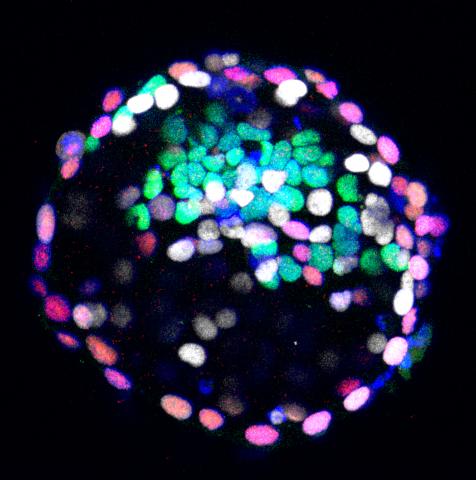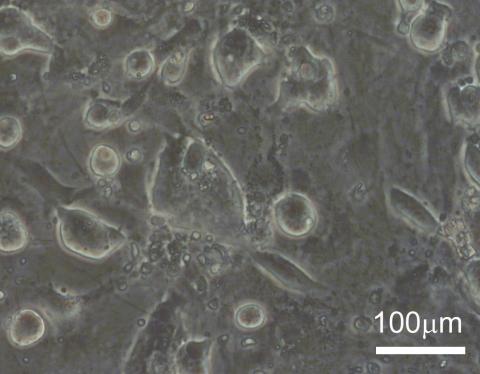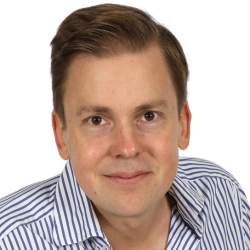Dr Thorsten Boroviak
Primate Embryogenesis
Departmental affiliation: Department of Physiology, Development and Neuroscience, Centre for Trophoblast Research
Biography
Thorsten originates from Austria, where he studied Molecular Biology at the University of Vienna. After completion of his master’s thesis in 2007, he was awarded a PhD-fellowship at the University of Sheffield to work on neuronal differentiation of mouse embryonic stem cells. Thorsten early postdoctoral work in the laboratories of Prof. Austin Smith and Prof. Jennifer Nichols provided transcriptional and functional evidence that the closest in vivo counterpart of mouse embryonic stem cells is the preimplantation epiblast. Between 2012 and 2015, he pioneered genome-wide comparison of mouse to non-human primate development by lineage-specific RNA-seq, which identified a primate-specific role for WNT signaling during early lineage specification. In 2017, Thorsten was awarded a Sir Henry Dale Fellowship to start his own group – the Laboratory for Primate Embryogenesis – at the Department of Physiology, Development and Neuroscience at the University of Cambridge. Thorsten is a member of the Cambridge Stem Cell Institute, the Centre for Trophoblast Research, the Anne McLaren Trust Fund and Fellow of Darwin College.
Research
The Boroviak lab focuses on how embryonic cells organise themselves to form the most complex lifeforms, such as human and non-human primates.
They follow primate embryonic cells through parts of their journey to provide insights into human development. Their approaches include simultaneous genetic and epigenetic high-throughput sequencing from single cells, embryonic stem cell culture and bioengineering of stem cell-based embryo models.
A deeper understanding of primate development is vital for innovative treatments of implantation failure, infertility and cancer as well as clinical applications of stem cell biology.
Embryo implantation, gastrulation and organogenesis
The first signs of the human body axis can be traced back to the second week of gestation. To get to this point, the blastocyst implants and establishes a small sheet of cells, the embryonic disc. Deeply embedded within extraembryonic tissues, the embryo undergoes a reorganization process termed “gastrulation”, which transforms the embryonic disc into three germ layers and determines the entire future body plan.
Most of our knowledge on mammalian gastrulation is based on mouse, but human embryogenesis differs in anatomical architecture, timing, molecular configuration and sequence of cell-fate decisions. For instance, in human and non-human primates, the implanting epiblast polarises into a rosette, gives rise to amnion and forms a flat EmDisc. Rodent embryos form amnion later in development, after gastrulation.
Research goals
The central aim of our research focuses on delineating the molecular crosstalk between the human embryonic disc and extraembryonic signalling centres, which control the sequence of cell-fate allocation in the primitive streak. To understand how these signalling centres emerge, we need to elucidate how extraembryonic lineages are specified in primate postimplantation development.

Marmoset blastocyst stained with markers of the three lineages: epiblast, hypoblast and trophoblast.
Our lab was the first to reveal the molecular landscape in primate embryos between implantation and gastrulation in vivo (Bergmann et al., Nature 2022). We developed epiblast- and amnion-spheroid cultures using microfluidics (Schindler et al., Stem Cell Reports 2021; Munger et al., Development 2022) and pioneered computational approaches, including spatial-identity-mapping, to determine the identity of in vitro cultured cells. Our ongoing work involves micropatterning, blastoids, microfluidics and bioprinting to emulate human and non-human primate development in stem cell-based embryo models.

Epiblast-like marmoset embryonic stem cells
The results from our work will be critical to understand human implantation failure, how errors in gastrulation can lead to congenital malformations and how germ layers are patterned for organ formation.
Spatial transcriptome profiling of primate embryos - view the video
Publications:
-
Castillo-Venzor A, Penfold CA, Morgan MD, Tang WW, Kobayashi T, Wong FC, Bergmann S, Slatery E, Boroviak TE, Marioni JC, Surani MA. Origin and segregation of the human germline. Life Sci Alliance, 2023
- Kraunsoe S, Azami T, Pei Y, Martello G, Jones K, Boroviak TE, Nichols J. Requirement for STAT3 and its target, TFCP2L1, in self-renewal of naïve pluripotent stem cells in vivo and in vitro. Biology Open, 2023.
- Sheng G, Boroviak TE, Schmidt-Ott U, Srinivas S. Extraembryonic tissues: exploring concepts, definitions and functions across the animal kingdom. Philosophical Transactions of the Royal Society B, 2022
- Siriwardena D, Boroviak TE. Evolutionary divergence of embryo implantation in primates. Philosophical Transactions of the Royal Society B, 2022
- Munger C, Kohler TN, Slatery E, Ellermann AL, Bergmann S, Penfold CA, Ampartzidis I, Chen Y, Hollfelder F, Boroviak TE. Microgel culture and spatial identity mapping elucidate the signaling requirements for primate epiblast and amnion formation. Development, 2022
- Chen Y, Siriwardena D, Penfold C, Pavlinek A, Boroviak TE. An integrated atlas of human placental development delineates essential regulators of trophoblast stem cells. Development, 2022
- Malkowska A, Penfold C, Bergmann S, Boroviak TE. A hexa-species transcriptome atlas of mammalian embryogenesis delineates metabolic regulation across three different implantation modes. Nature Communications, 2022
- Bergmann S, Penfold CA, Slatery E, Siriwardena D, Drummer C, Clark S, Strawbridge SE, Kishimoto K, Vickers A, Tewary M, Kohler TN, Hollfelder F, Reik W, Sasaki E, Behr R, Boroviak TE. Spatial profiling of early primate gastrulation in utero. Nature, 2022.
- Boroviak TE. A human embryo model cracks symmetry breaking. Cell Stem Cell, 2022
- Bergmann S, Schindler M, Munger C, Penfold CA, Boroviak TE. Building a stem cell based primate uterus. Nature Communications Biology, 2021.
- Schindler M, Siriwardena D, Kohler TN, Ellermann AL, Slatery E, Munger C, Hollfelder F, Boroviak TE. Agarose microgel culture delineates lumenogenesis in naive and primed human pluriopotent stem cells. Stem Cell Reports, 2021
- Betto RM, Diamante L, Perrera V, Audano M, Rapelli S, Lauria A, Incarnato D, Arboit M, Pedretti S, Rigoni G, Guerineau V, Touboul D, Stirparo GG, Lohoff T, Boroviak T, Grumati P, Soriano ME, Nichols J, Mitro N, Oliviero S, Martello G. Metabolic control of DNA methylationin naive pluripotent cells. Nature Genetics, 2021.
- Stirparo GG, Kurowski A, Yanagida A, Bates LE, Strawbridge SE, Hladkou S, Stuart HT, Boroviak TE, Silva JCR, Nichols J. OCT4 induces embryonic pluripotency via STAT3 signalling and metabolic mechanisms. PNAS, 2021
- Connor R. and Boroviak T, Origin and function of the yolk sac in primate embryogenesis, Nature Communications, 2020
- Boroviak T, Stirparo GG, Dietmann S, Hernando-Herraez I, Mohammed H, Reik W, Smith A, Sasaki E, Nichols J, Bertone P, (2018), Single cell transcriptome analysis of human, marmoset and mouse embryos reveals common and divergent features of preimplantation development, Development 2018
- Stirparo GG, Boroviak T, Guo G, Nichols J, Smith A, Bertone P (2018), Integrated analysis of single-cell embryo data yields a unified transcriptome signature for the human pre-implantation epiblast, Development 2018
- Boroviak T and Nichols J, (2017), Postimplantation development predicts extraembryonic potential of naive pluripotency in primates, Development, 2017
- Scognamiglio R, Cabezas-Wallscheid N, Their M, Altamura S, Reyes A, Baumgärtner D, Prendergast A, Carnevalli L, Paleske L, Boroviak T, Wörsdörfer P, Essers M, Eisenman R, Edenhofer F, Bertone P, Huber W, Hoeven F, Smith A and Trumpp A, Myc Depletion Induces a Pluripotent Dormant State Mimicking Diapause, Cell, 2016
- Boroviak T*, Loos R*, Lombard P, Behr R, Sasaki E, Nichols J, Smith A and Bertone P, (2015), Lineage-specific profiling delineates the emergence and progression of naïve pluripotency in mammalian embryogenesis, Developmental Cell, 2015
- Boroviak T. and Nichols J, (2015), Maximising clonal embryonic stem cell derivation by ERK pathway inhibition, Methods in Molecular Biology, 2015
- Boroviak T. and Nichols J, (2014), The birth of embryonic pluripotency, Philosophical transactions of the Royal Society 2014
- Boroviak T, Loos R, Bertone P, Smith A and Nichols J, The ability of inner cell mass cells to self-renew as embryonic stem cells is acquired upon epiblast specification, Nature Cell Biology 2014
- Tatsumoto S, Adati N, Tohtoki Y, Sakaki Y, Boroviak T, Habu S, Okano H, Suemizu H, Sasaki E and Satake M, (2013), Development and characterization of cDNA resources for the common marmoset: one of the experimental primate models, DNA Res. 2013
- Boroviak T. and Rashbass P, (2010), The Apical Polarity Determinant Crumbs 2 is a Novel Regulator of Embryonic Stem Cell Derived Neural Progenitors, Stem Cells 2010
- Reitinger S, Boroviak T, Laschober GT, Fehrer C, Muellegger J, Lindner H, Lepperdinger G, (2008), High-yield recombinant expression of the extremophile enzyme, bee hyaluronidase in Pichia pastoris, Protein Expr Purif. 2008


